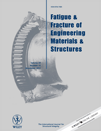Effect of weld orientation on static strength and failure mode of friction stir stitch welds in lap-shear specimens of aluminium 6022-T4 sheets
ABSTRACT
Stitch friction stir spot welding (FSSW) is performed on 6022-T4 Al alloy using a concave shoulder tool with cylindrical pin. Stitch FSSW is an extension of the conventional spot FSW process where an elongated (oval) spot is produced instead of a circular spot. The main advantage of this process is that it gives appreciably higher strength than conventional spot FSW due to an increase in the joint area. In this research, an experimental and numerical approach is taken to understand the failure mechanism of stitch welds made in lap-shear configuration. There are four ways (orientations) in which specimens can be welded to produce a lap-shear specimen – two in transverse direction and two in longitudinal direction. The static strength of welds made with these orientations was found to be different. For stitch welds made in the longitudinal orientation, the failure always occurred near the keyhole at the tool retract position. For welds made in the transverse orientation, failure always occurred in the region of the highest stress. This difference in the weld strength can be attributed to the hook geometry and interface bond strength. The results are explained using a kinked cracked model approach and calculation of stress intensity factor at the hook geometry.




